No difference in anterior tibial translation with and without posterior cruciate ligament in less invasive total knee replacement
- نوع فایل : کتاب
- زبان : انگلیسی
- مؤلف : Bernhard Christen • Michal Neukamp • Emin Aghayev
- چاپ و سال / کشور: 2011
Description
Purpose The relative advantages of cruciate retaining or cruciate resecting total knee replacement are still controversial. If the posterior cruciate ligament (PCL) is preserved, it should be properly balanced. In a previous study, it was demonstrated that increasing the flexion gap leads to an anterior translation of the tibia relative to the femur. Based on these results, we hypothesized that cutting the PCL increases the flexion gap and lessens anterior tibial translation. Methods The amount of anterior tibial translation versus distraction force in the flexion gap was measured in 88 total knee replacements with a less invasive midvastus approach using a custom-made tensioner. Measurements were performed with intact and resected PCL. Results The difference in tibial translation with and without PCL is not significant. A 1-mm increase in the flexion gap led to an average anterior translation of 0.6 mm with intact PCL and 0.4 mm with cut PCL, which is less than that reported in a previous study. Conclusions The results have not confirmed our initial hypothesis. The reasons for this may be other soft tissue structures that prevent anterior tibial translation, such as the collateral ligaments, and/or the extensor apparatus. Moreover, the knee flexion angle for the used specific implant may play a role.
Knee Surg Sports Traumatol Arthrosc DOI 10.1007/s00167-011-1560-7 Received: 1 December 2010 / Accepted: 19 May 2011


